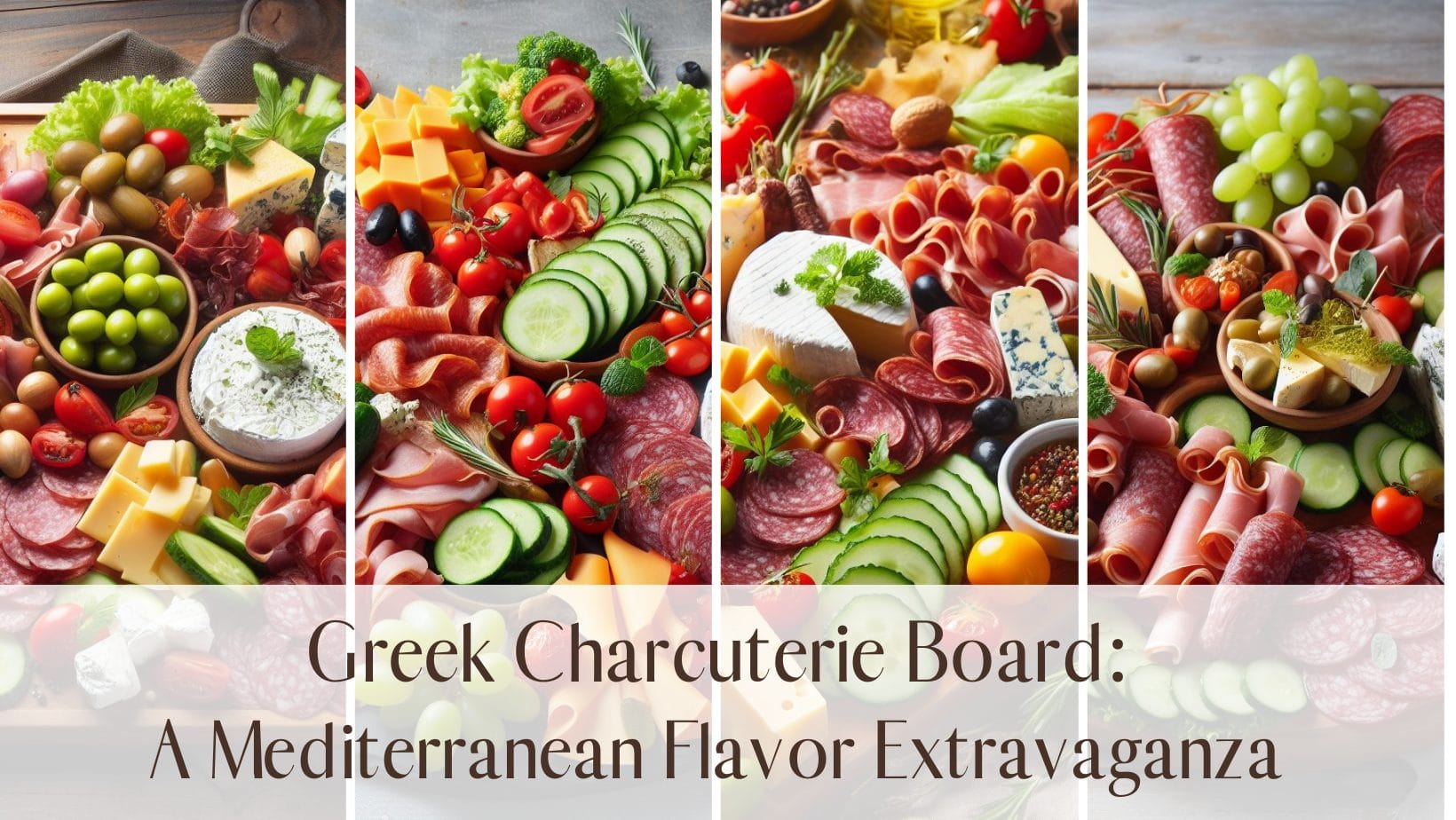Picture this: a beautifully crafted board adorned with the finest Greek ingredients, a symphony of flavors dancing on your palate. If you're a Greek food enthusiast or simply looking to impress your guests, a Greek charcuterie board is your culinary masterpiece waiting to happen. In this article, we'll guide you through every step of creating a Greek charcuterie board that's not just a feast for the taste buds but a work of art. From authentic ingredients to wine pairings, we'll help you elevate your charcuterie game with a touch of Mediterranean magic.
Table of Contents [CLICK HERE TO OPEN]
- Ingredients for a Greek Charcuterie Board
- Creating a Harmonious Flavor Profile
- Assembling Your Greek Charcuterie Board
- Occasions for Serving Greek Charcuterie
- Wine Pairing Recommendations
- Dietary Considerations and Variations
- Etiquette and Enjoying Your Greek Charcuterie
- Wrapping It Up
- Frequently Asked Questions

Ingredients for a Greek Charcuterie Board
When it comes to crafting the perfect Greek charcuterie board, the secret is in the ingredients. It's not just about what you include but the authenticity and quality of those ingredients that will transport your taste buds to the Mediterranean.
Greek Cheeses: Begin with the star of the show – Greek cheeses. Feta, known for its crumbly texture and tangy flavor, is a must-have. Kasseri, a semi-hard cheese, adds a delightful mildness. And then there's halloumi, the cheese that grills like a dream, creating a delightful contrast of textures.
Olives: Now, let's talk olives. Greek olives are legendary, and your board should feature a variety. Kalamata olives, known for their rich, fruity taste and dark color, are a classic choice. Green olives provide a briny contrast, and stuffed olives, often filled with goodies like garlic or feta, add a surprise element.
Cured Meats: No charcuterie board is complete without some cured meats. Salami and prosciutto are excellent choices. The savory, slightly spicy salami pairs perfectly with the other ingredients. Prosciutto, with its delicate, melt-in-your-mouth quality, adds a touch of luxury.
Fresh Fruits: To brighten up the board, add fresh fruits. Figs, with their sweet and earthy flavor, bring a touch of elegance. Grapes, sweet and juicy, provide a refreshing burst of flavor. They're like nature's candy, perfectly balancing the savory elements.
Nuts and Dried Fruits: Nuts and dried fruits not only provide crunch but a dose of Mediterranean goodness. Almonds, walnuts, and pistachios are excellent choices. Pair them with dried apricots, apricots, or figs for a delightful contrast.
Bread and Crackers: Lastly, the foundation of your board – bread and crackers. Sourdough or a baguette provides a hearty base for your flavors. Crisp crackers add that essential crunch.
Remember, the key is authenticity and quality. Seek out Greek ingredients when possible to create a true Greek charcuterie experience. It's all about savoring the Mediterranean, one delicious bite at a time.

Creating a Harmonious Flavor Profile
Now that you've assembled the lineup of Greek ingredients for your charcuterie board, let's delve into the art of creating a harmonious flavor profile that will leave your taste buds singing in delight.
Balancing Salty, Savory, and Sweet
A successful Greek charcuterie board is all about balance. You want to tantalize your palate with a symphony of tastes. Start with salty elements like feta, olives, and cured meats. They provide that initial savory punch. Then introduce the sweet notes with fresh fruits like figs and grapes. These bursts of sweetness beautifully counterbalance the saltiness. And somewhere in between, you'll find the mild and creamy Greek cheeses like kasseri and halloumi, adding their own unique flavors to the mix.
Pairing Complementary Ingredients
The magic of a charcuterie board lies in the pairings. Consider how the ingredients complement one another. For instance, the saltiness of olives pairs wonderfully with the creaminess of feta. The savory richness of salami finds its match in the subtle nuttiness of almonds. Don't be afraid to mix and match – explore different combinations to discover your own personal favorites.
Exploring Textures for a Delightful Experience
Textures play a crucial role in the charcuterie experience. The crumbly, creamy, and soft nature of Greek cheeses offers a delightful contrast to the crispness of crackers and the crunch of nuts. The velvety, melt-in-your-mouth quality of prosciutto complements the denseness of bread. Figs add a chewy, fruity dimension to your board. It's these textural variations that keep every bite exciting and engaging.
So, in your quest to create the ultimate Greek charcuterie board, remember the symphony of flavors and textures at your disposal. Embrace the salty, savor the savory, and delight in the sweet. Experiment with pairings, and craft a board that offers a sensory journey through the Mediterranean's culinary delights.
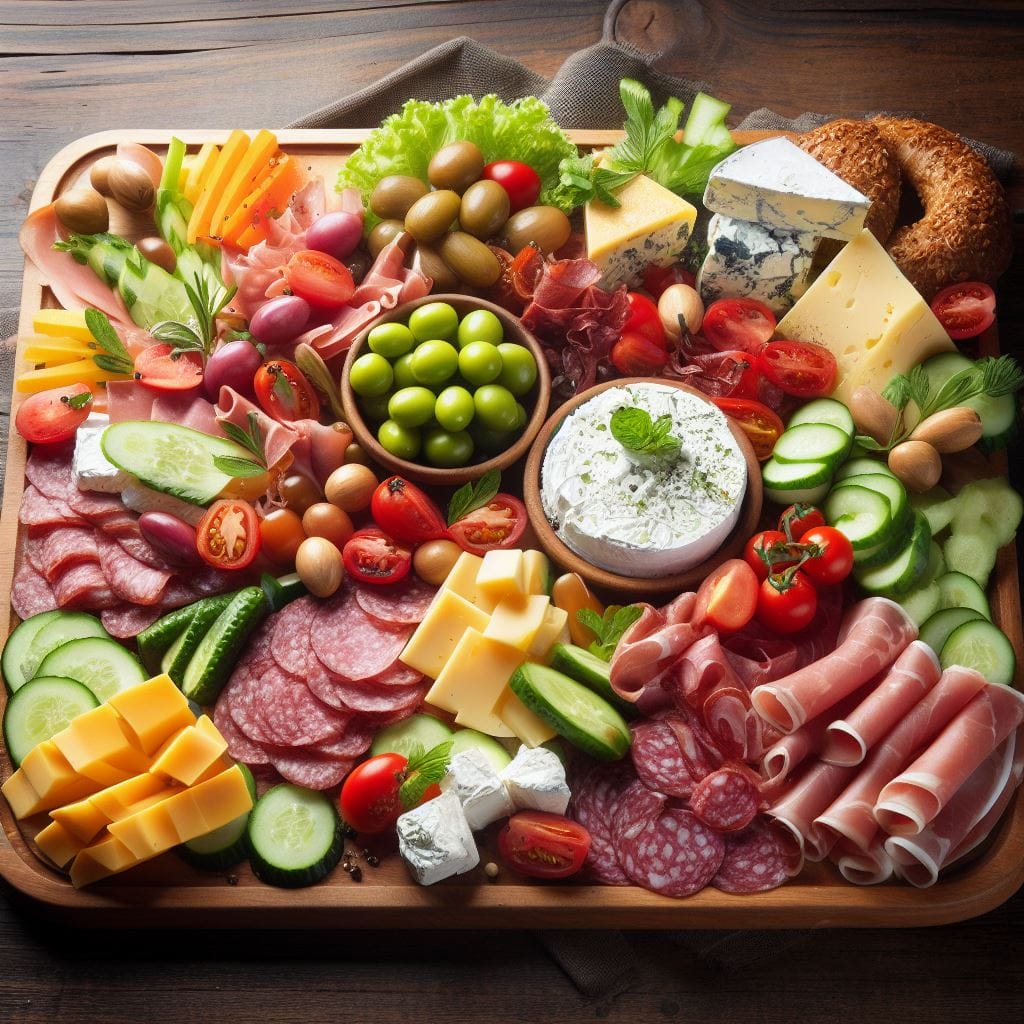
Assembling Your Greek Charcuterie Board
Now that you've gathered your authentic Greek ingredients and mastered the art of balancing flavors and textures, it's time to transform these elements into a visually enticing and delectable Greek charcuterie board. Here's a step-by-step guide to help you assemble your masterpiece.
Step-by-Step Guide:
- Start with the cheeses. Place them strategically, allowing them to shine as the focal points of your board.
- Arrange the cured meats, draping them elegantly or folding them for a touch of sophistication.
- Fill gaps with olives, ensuring they're evenly distributed for accessibility.
- Add fresh fruits like figs and grapes in clusters, creating visual appeal.
- Sprinkle nuts and dried fruits throughout to maintain a harmonious balance.
- Artfully position bread and crackers as the foundation, providing a canvas for the other ingredients.
Tips for an Aesthetically Pleasing Display:
- Use a wooden board or platter for an authentic Mediterranean feel.
- Incorporate a variety of colors for an eye-catching presentation.
- Play with different shapes and sizes to add visual interest.
- Create symmetry and balance in your arrangement.
- Leave some space for the board to breathe, avoiding overcrowding.
Styling and Garnishing Ideas to Enhance Presentation:
- Fresh herbs like rosemary or basil can serve as beautiful garnishes.
- Small dishes of Greek olive oil and balsamic vinegar for dipping.
- A drizzle of honey over the cheeses for a touch of sweetness.
- Edible flowers for a whimsical and picturesque touch.
Your Greek charcuterie board isn't just about taste; it's an edible work of art. As you assemble the ingredients and apply these tips, you'll not only create a delicious masterpiece but a visually stunning one. The combination of flavors and the aesthetic appeal will leave your guests in awe of your culinary prowess.

Occasions for Serving Greek Charcuterie
Your expertly crafted Greek charcuterie board is ready to dazzle, but when and where should you share this Mediterranean marvel? Let's explore the occasions that are perfect for indulging in this culinary delight.
Hosting Greek-Themed Parties and Gatherings
Planning a Greek-themed soirée? Your charcuterie board is a superb addition. Whether it's a birthday celebration, a summer get-together, or a Greek holiday like Easter, your board will be the star of the event. Pair it with Greek music, décor, and perhaps some ouzo for an authentic experience.
Special Occasions Like Weddings and Celebrations
Elevate your special day with a touch of Greek charm. A Greek charcuterie board can be an ideal appetizer for weddings or milestone celebrations. It sets the tone for an elegant and memorable event, offering a delectable taste of Greece to your guests.
Serving Suggestions
But it's not just about the ‘when'—consider the ‘where' too. Your Greek charcuterie board isn't limited to indoor dining. Take it outdoors for picnics or beach gatherings. It's perfect for a romantic evening under the stars or a cozy date night at home. The versatility of this creation knows no bounds.
So, whether you're embracing Greek culture at a themed party, adding flair to a special occasion, or enjoying a casual outdoor outing, your Greek charcuterie board is a versatile and delightful choice. Its rich flavors and stunning presentation will make any occasion extra special.
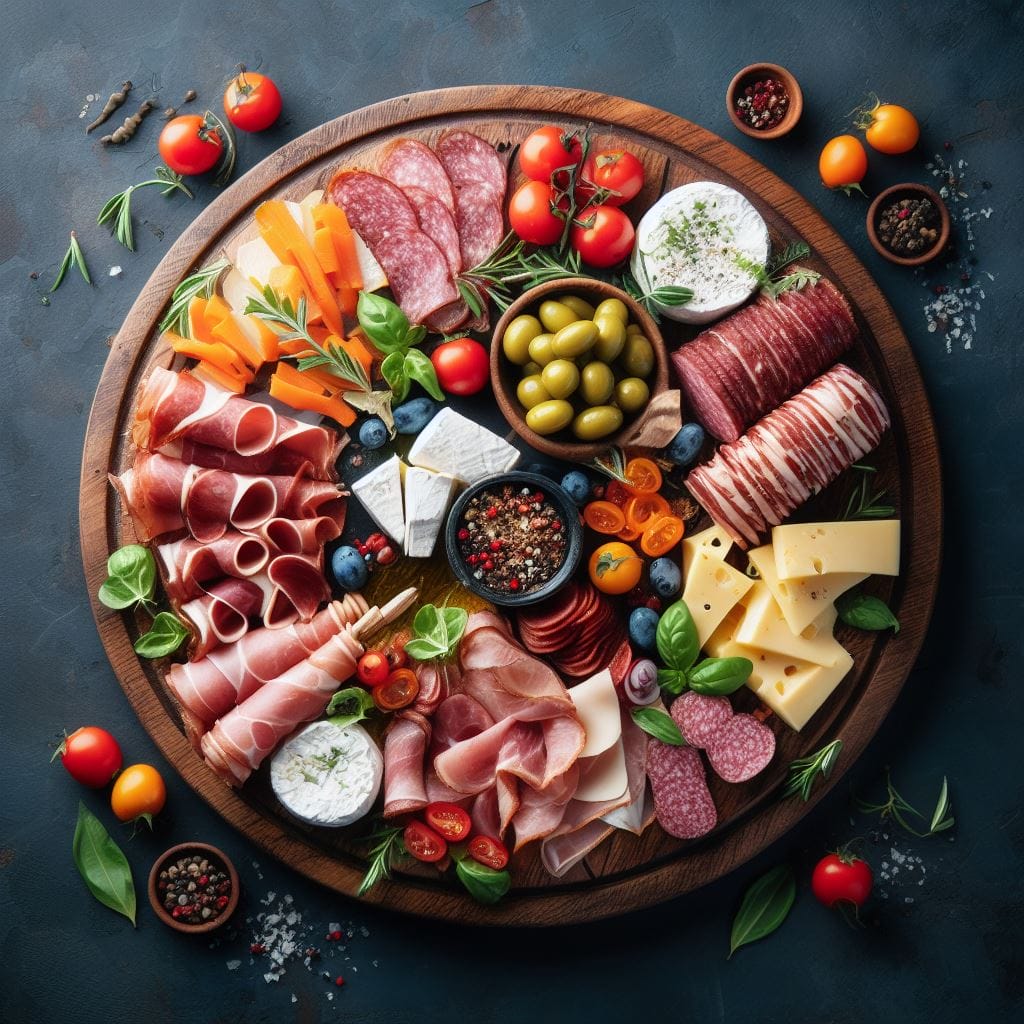
Wine Pairing Recommendations
Pairing wine with your Greek charcuterie board is like a beautiful dance of flavors. Let's explore the art of wine and charcuterie pairing and discover some delectable Greek wine recommendations to elevate your culinary experience.
The Art of Pairing Wine with Charcuterie:
Pairing wine with charcuterie is an art that involves balancing the flavors and textures of your board with the characteristics of the wine. Here's a quick guide:
- Red Wines: Rich and full-bodied reds like Cabernet Sauvignon or Syrah complement the intensity of cured meats and cheeses. They create a harmonious union of flavors.
- White Wines: Crisp and acidic whites like Sauvignon Blanc or Assyrtiko cut through the richness of the cheeses and olives, refreshing your palate.
- Rosé Wines: A versatile choice, rosé wines offer a balance between red and white. They pair well with a variety of ingredients, adding a touch of elegance.
- Sparkling Wines: Sparkling wines like Prosecco or Greek Assyrtiko sparkling wines can cleanse the palate between bites, enhancing your appreciation of the different flavors.
Greek Wine Recommendations:
For a truly Greek experience, consider these wine options:
- Assyrtiko: A crisp and mineral-rich white wine that pairs wonderfully with Greek cheeses and seafood.
- Xinomavro: A red wine known for its complexity and structure, a great match for cured meats and bold cheeses.
- Agiorgitiko: A red wine with fruity notes, ideal for lighter cured meats and olives.
- Moschofilero: A floral and aromatic white wine that complements the freshness of fruits and lighter cheeses.
Rationale behind these recommendations: The wine selections are made to enhance the flavors of your Greek charcuterie board. The Assyrtiko's acidity balances rich cheeses, while the Xinomavro's depth complements savory cured meats. Agiorgitiko's fruitiness pairs well with olives, and Moschofilero's aromatic qualities highlight the fresh fruits.
So, as you create your Greek charcuterie board, don't forget to choose a Greek wine that harmonizes with the flavors. The right wine pairing can transform your charcuterie experience into a symphony of tastes and aromas.
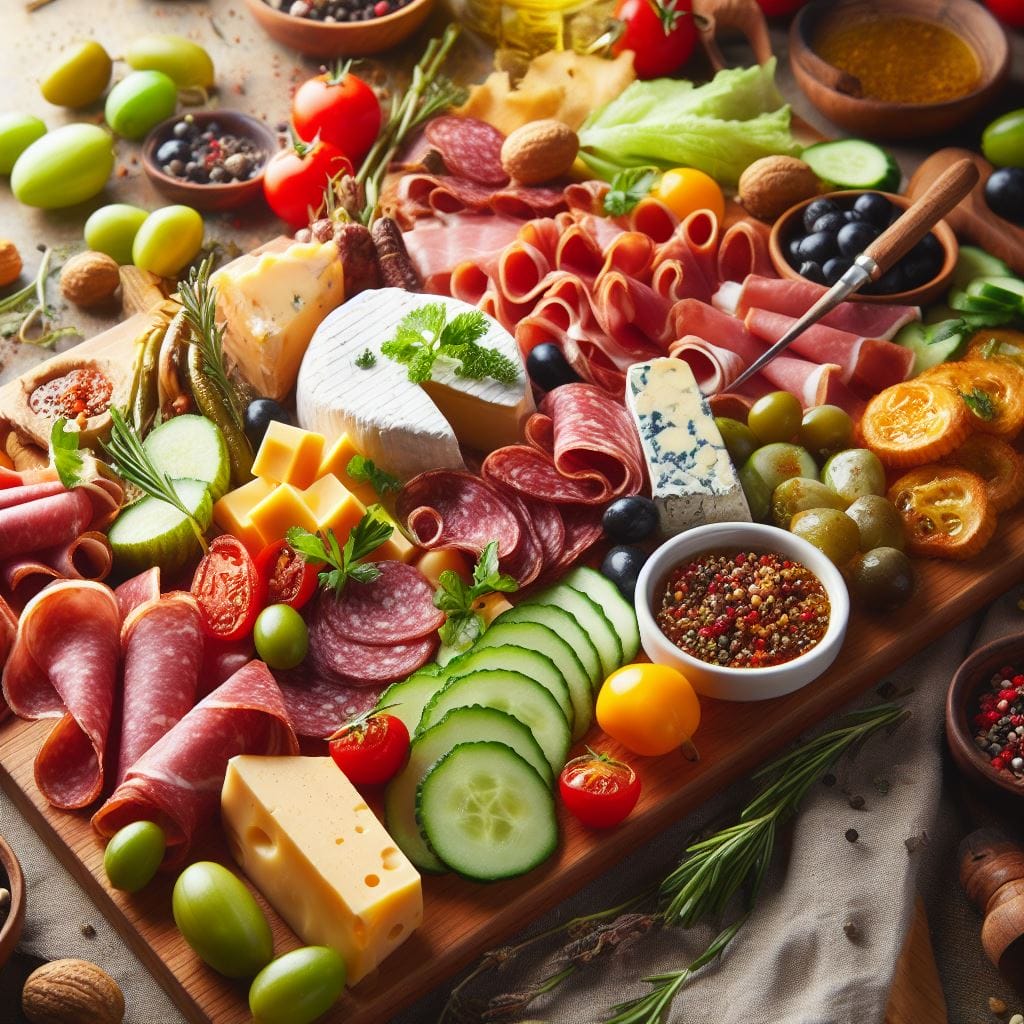
Dietary Considerations and Variations
Dietary preferences and needs vary, and your Greek charcuterie board can adapt to accommodate them. Let's explore options for low-carb and keto-friendly boards, vegetarian and vegan variations, and allergen-free alternatives.
Options for Low-Carb and Keto-Friendly Boards:
- Keto Substitutes: Swap traditional bread and crackers for keto-friendly options like almond flour crackers or cheese crisps. These choices are low in carbs, allowing you to enjoy the essence of a charcuterie board while staying keto.
- Lean Meats: Choose lean cured meats like turkey or chicken breast, which are lower in fat and carbohydrates than some traditional charcuterie options.
- Healthy Fats: Incorporate avocados, which are keto-friendly and add a creamy texture. Additionally, include nuts like almonds and walnuts for healthy fats and a satisfying crunch.
- Berries: For a touch of sweetness without excessive carbs, consider adding a small portion of berries like strawberries or blueberries.
Vegetarian and Vegan Variations:
- Plant-Based Meats: Explore plant-based alternatives like vegan sausages or tempeh as a substitute for traditional cured meats.
- Dairy-Free Cheeses: Opt for dairy-free Greek cheese substitutes made from ingredients like cashews or almonds.
- Legumes and Hummus: Legumes can provide a hearty protein source. Hummus, tzatziki, or baba ghanoush make excellent plant-based dips.
- Load Up on Veggies: Incorporate an array of colorful vegetables, such as cherry tomatoes, cucumbers, and bell pepper strips.
Allergen-Free Alternatives:
- Gluten-Free Options: Select gluten-free crackers or bread for those with gluten sensitivities or allergies.
- Allergen Labeling: Clearly label any dishes with potential allergens such as nuts or dairy to ensure guests with allergies are well-informed.
- Cross-Contamination Awareness: When preparing the board, take precautions to minimize cross-contamination between allergen-free and regular ingredients.
By offering these dietary variations and alternatives, your Greek charcuterie board becomes an inclusive delight that caters to a wide range of dietary needs and preferences, ensuring that everyone can savor the Mediterranean flavors in a way that suits them best.

Etiquette and Enjoying Your Greek Charcuterie
Your Greek charcuterie board is a masterpiece of taste and aesthetics, but serving and enjoying it with guests requires a touch of finesse. Let's explore the art of serving, share cultural significance, and offer etiquette tips for an unforgettable experience.
How to Serve and Enjoy the Board with Guests:
- Presentation: Place your Greek charcuterie board where everyone can see and reach it. A wooden platter or board adds an authentic touch.
- Sharing: Encourage your guests to help themselves but with a dose of consideration. Don't let anyone hog the entire board.
- Small Plates: Provide small plates or individual dishes for guests to assemble their bites without contaminating the main board.
Cultural Significance and Traditions:
- Greek Tradition: In Greece, the concept of ‘meze' is akin to charcuterie. It's about communal dining, savoring small bites with friends and family while enjoying conversation and company.
- Olive Branch: In Greek culture, offering an olive branch signifies peace and goodwill. Incorporating olives on your board connects to this symbolism.
- Ouzo Toast: On special occasions, Greeks often enjoy their meze with ouzo, a traditional Greek spirit. Raise a toast and celebrate in this spirit of camaraderie.
Etiquette Tips for a Memorable Experience:
- Appreciation: Encourage your guests to appreciate the rich flavors and textures on the board. It's not just about eating but savoring the experience.
- Engaging Conversation: Create an atmosphere of conviviality. The board is a conversation starter, and the real magic happens when you share stories and laughter.
- Mindful Consumption: Ensure that everyone gets a chance to enjoy the charcuterie board, and avoid overindulging, allowing the experience to linger.
By serving your Greek charcuterie board with grace, understanding its cultural context, and observing etiquette, you transform a meal into a memorable social event. It's a celebration of not just the food but the connections and conversations it sparks. So, indulge in the culinary artistry of Greece, share stories, and create lasting memories with your loved ones. Enjoy!

Wrapping It Up
Now, it's your turn to embrace the art of crafting a Greek charcuterie board. Don't hesitate to get creative and tailor your board to your preferences and the occasion at hand. Experiment with different ingredients, pairings, and wine choices. Let your imagination run wild and savor the joy of creating your own culinary masterpiece.
We encourage you to share your Greek charcuterie creations on social media, where you can inspire others with your artistry. And for more culinary adventures, explore our related articles to continue your journey through the world of delightful food and drink.
Cheers to the rich tapestry of Greek flavors and the culinary magic of the Mediterranean!
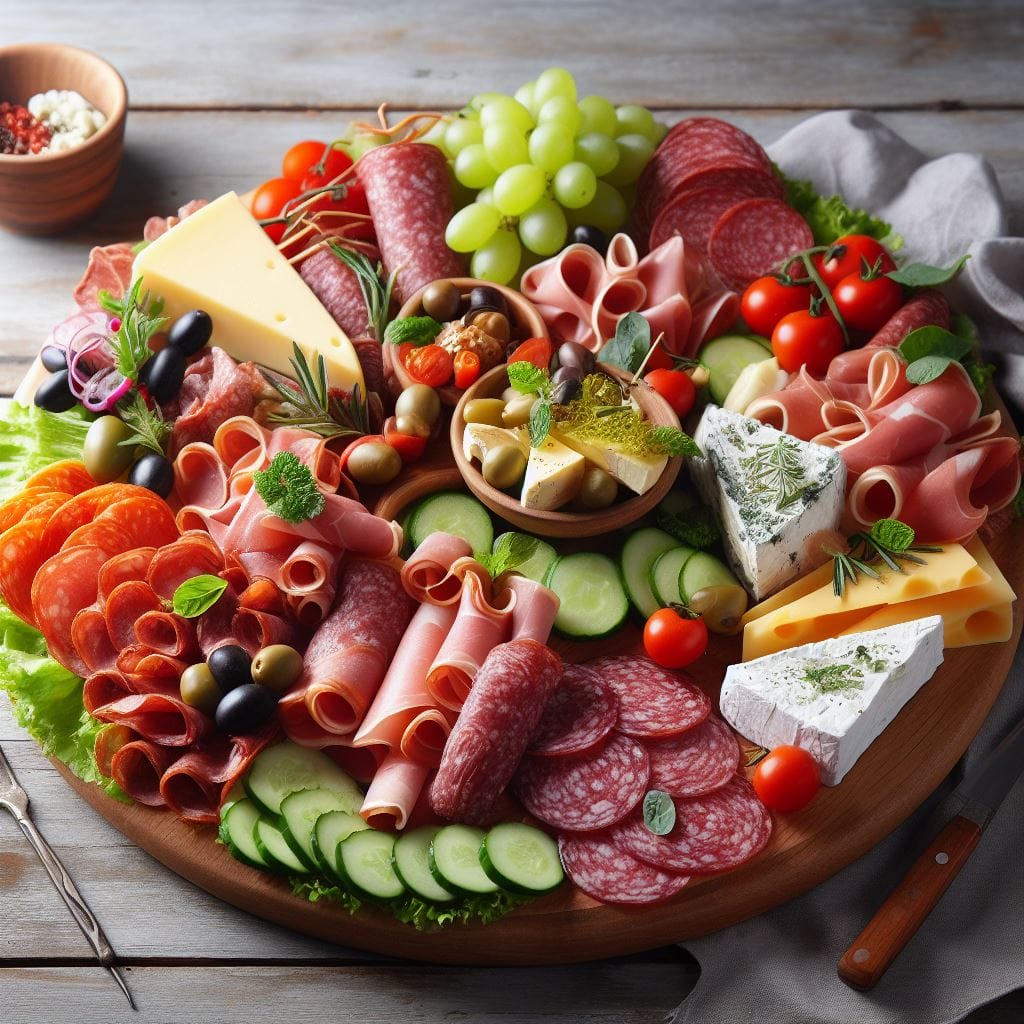
Frequently Asked Questions
What is a Greek charcuterie?
A Greek charcuterie is a platter or board filled with a variety of traditional Greek foods, such as Greek cheeses (like feta and halloumi), olives, cured meats (like salami and prosciutto), fresh fruits, nuts, and bread. It's a combination of savory and sweet flavors, often served at gatherings, parties, or special occasions, and can be accompanied by Greek wine for a complete experience.
What is the Greek version of prosciutto?
The Greek version of prosciutto is called “loukaniko.” It's a Greek cured meat typically made from pork and flavored with various spices, giving it a distinct Greek taste.
How do you make a Greek charcuterie board?
To make a Greek charcuterie board:
- Start with Greek cheeses like feta and kasseri.
- Add olives (Kalamata, green, stuffed), cured meats (salami, prosciutto), fresh fruits (figs, grapes), nuts, and bread.
- Balance flavors and textures.
- Arrange ingredients attractively on a platter.
- Consider wine pairings like Greek wines.
Share Your Creations:
We’d love to see the charcuterie boards you create using our guide! Feel free to share your own creations in the comments or on social media, and tag us for a chance to be featured. And if you have any other ideas or tips for creating the perfect charcuterie board, we’d love to hear them.

